Battling the elements, goats, and bureaucracy to protect the ecosystems at the top of Maui Koa trees and other native species are returning to the leeward side of Haleakalā.
By Judy Edwards
It was audacious. It was called impossible. It had to be done. It was the cusp of the 1980s and somebody had to fence the entire top of Maui’s Haleakalā Volcano, over 30 miles of it, immediately. Feral goats were destroying swathes of one of the most precious landscapes in the world. These unchecked ungulates churned up delicate cindery soils and crushed Hawaiian petrel nesting burrows.
They defecated aggressive, invasive weed seeds far and wide, and they grazed the iconic Haleakalā silverswords down to scraggly nubs – threatening the species’ very survival.
For those in the science and conservation community paying attention, things looked grim, very grim. At this rate, the rich, utterly unique wilderness at the summit of Haleakalā National Park would soon be a showpiece of dust, goats, broken ground, and weeds.
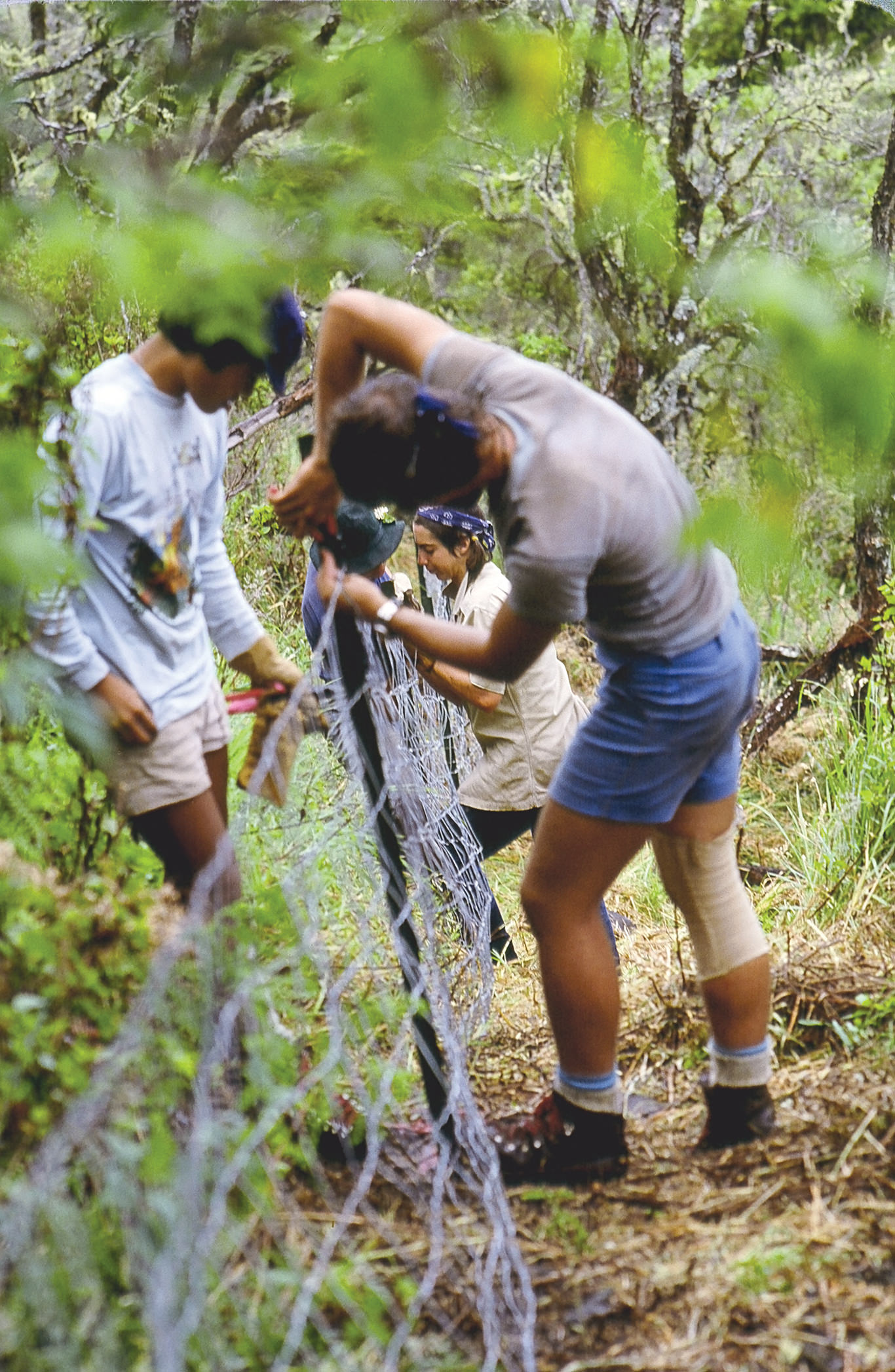
THE VOLCANO’S TRUE crater is long gone, washed down the flanks of the mountain to the sea – year after year, storm after storm. Erosion over the millennia scraped a gaping basin into the summit – 2,500 feet deep and seven and a half miles long. The northwest and southeast corners of the basin are marked by cavernous valleys: Ko‘olau Gap – which spills northward to become Keanae Valley and Kaupō Gap, respectively.
Isolation and evolution in the Hawaiian archipelago created an exquisite quilt of ecosystems on every island. Birds, plants and insects evolved from ancestor species that the wind, waves and wings of birds carried. Sheer distance kept land mammals and reptiles from arriving and establishing here. Rare forms of life arose, fitted exactly to their ecological niches.
High up in the cold air and ruthless sun on Maui’s Haleakalā, an ancestor of the sunflower gradually evolved. It became a fuzzy, silver, spiky ball that shot up one massed spike of flower clusters in its life, scenting the wind with the dusty fragrance of honey, cinnamon and oranges: the Haleakalā silversword.
The first people to come to Hawai‘i were Polynesians who settled in the coastal areas, farming and fishing. They brought small pigs and chickens with them, and likely rats as well. They gathered a bit in the forests, mindful of overharvesting and enacting strict protocols to keep the watershed healthy.
The summit of Haleakalā was the wao akua, the realm of the gods, and few approached it. Navigators and astronomers trained there, close to the heavens and the stars, then descended again into the warm world of daily life. The lower reaches of the islands were undeniably changed, but the upper forests and highlands remained relatively untouched.
Then the West found the islands in the late 1700s. British ships brought goats and pigs, cattle and horses. Many went feral. The 1800s saw the development of cattle ranches. By the 1900s many of the lower and middle slopes of East Maui were profoundly impacted – trampled and desiccated, grazed and depleted. Cattle ran wild, but goats ran wilder, breeding readily and eating everything they could find – right up Haleakalā’s slopes to the summit valley floor.
One traveler in 1913 wrote: “The steep slopes in the upper part of the Kaupō Gap are covered with this most beautiful plant (the silversword). Wild goats are doing great damage to it, as they devour it eagerly, and so also do cattle.”
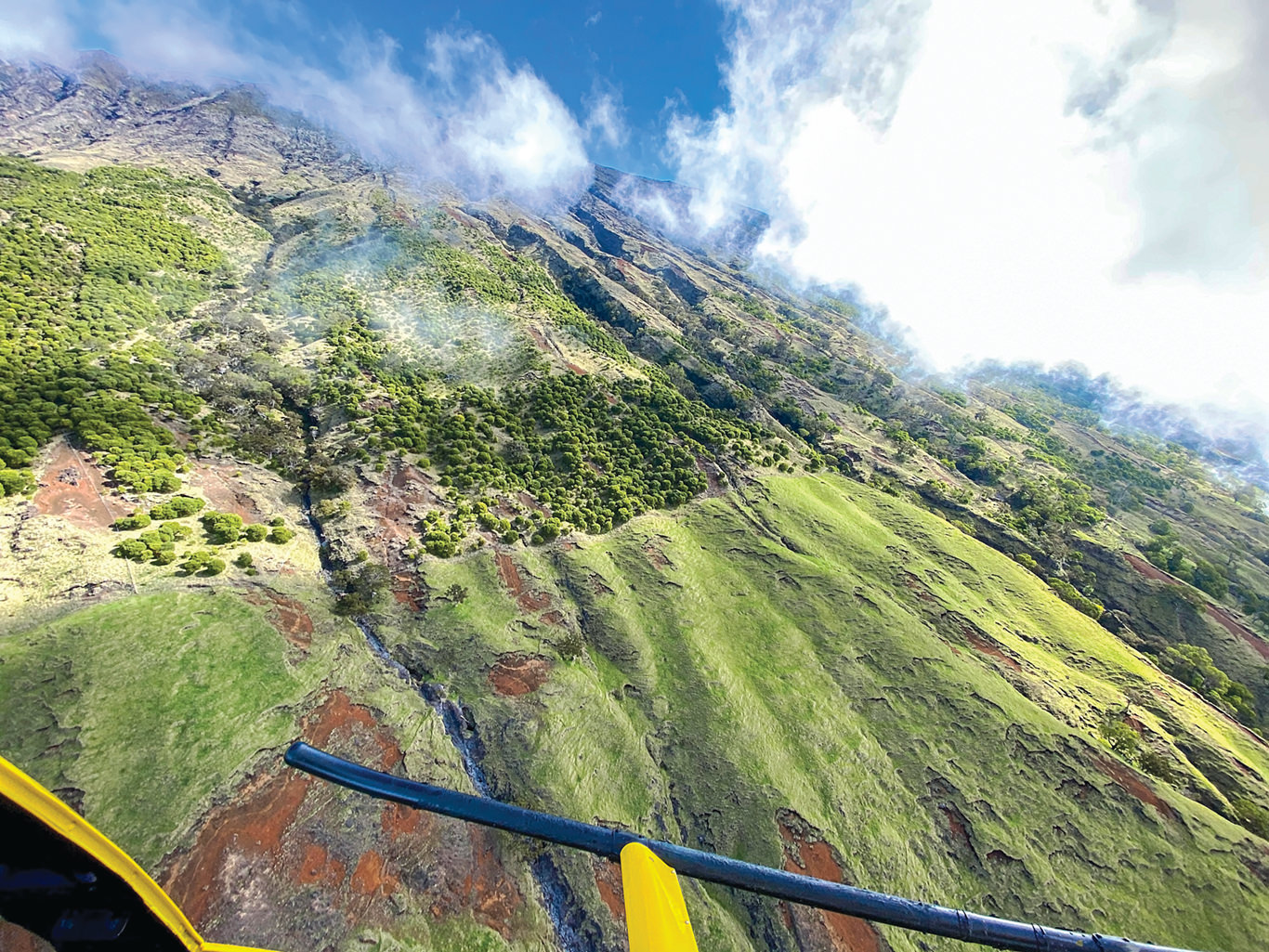
Fourteen years later, in 1927, botanist Otto Degener reported that “barely 100” silversword plants remained on Haleakalā.
But a new era of protection sparked in 1916, when large areas of Haleakalā Volcano were joined with Kīlauea and Mauna Loa volcanoes on Hawai‘i Island to form Hawaii National Park. In 1961, this park would split to become Haleakalā National Park on Maui and Hawai‘i Volcanoes National Park on Hawai‘i Island.
Some help arrived in the 1930s and 1940s when the Civilian Conservation Corps (CCC) came to Haleakalā to help with work projects, like fencing. They built goat fences but then moved on. Those fences eventually aged and failed.
Fencing the summit of Haleakalā was mentioned in national park memos in the 1950s, but no source of funding was available. A 1967 study reported that goats overgraze, disturb the soil and strip it, start landslides, and in some cases were responsible for more than 6 feet of erosion – the soil was stomped, degraded, and eventually washed away.
Meanwhile, an experiment was underway at Hawai‘i Volcanoes National Park. Fenced exclosures – plots of land where the native forest was fenced in and feral animals fenced out – showed native plants could recover once goats were removed.
In 1971, a fiery new leader roared into Hawai‘i Volcanoes National Park. Superintendent Bryan Harry called the “goddamn goats” a “national issue.”
Harry, now in his 90s and living on O‘ahu, said recently in an interview for this story that without the fences, the native ecosystems at Hawai‘i Volcanoes National Park were “going to hell in a handbasket.”
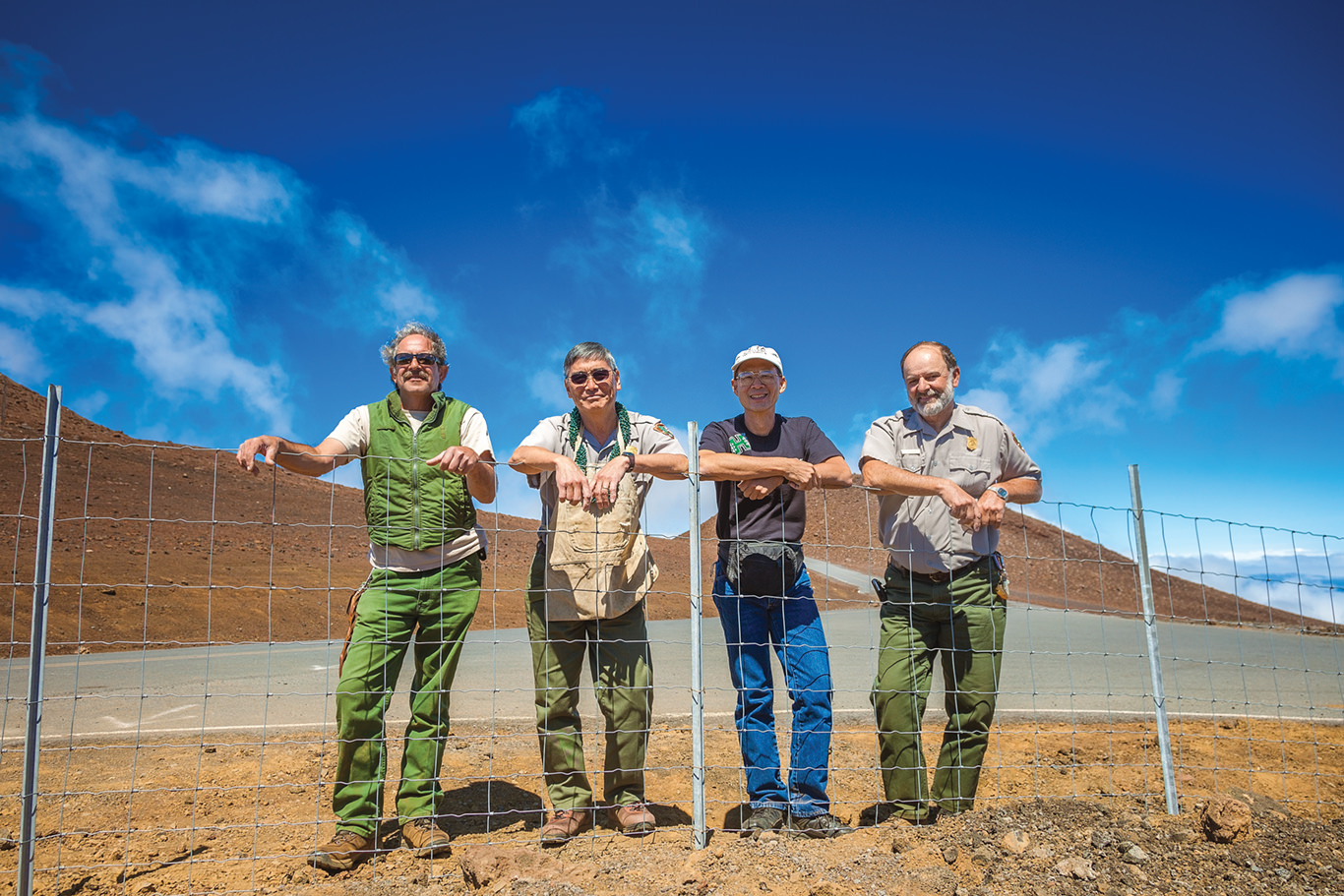
Photographer
http://www.dnwphoto.com
Harry began to push Washington for fence funding. If he couldn’t get the money, he was prepared to “steal it” from the other park projects: “Not to paint the houses, not to cut the weeds, but to build some fences,” he said.
When fences were built at Volcanoes, they concentrated the goats and made them simpler to remove. A multi-skilled and multi-tasking park ranger named Don Reeser became the first person to inhabit a new department Harry created called Resources Management to care for the natural resources of the park.
Soon, the new department became a model throughout the National Park Service. “It turned out to be contagious,” Harry said.
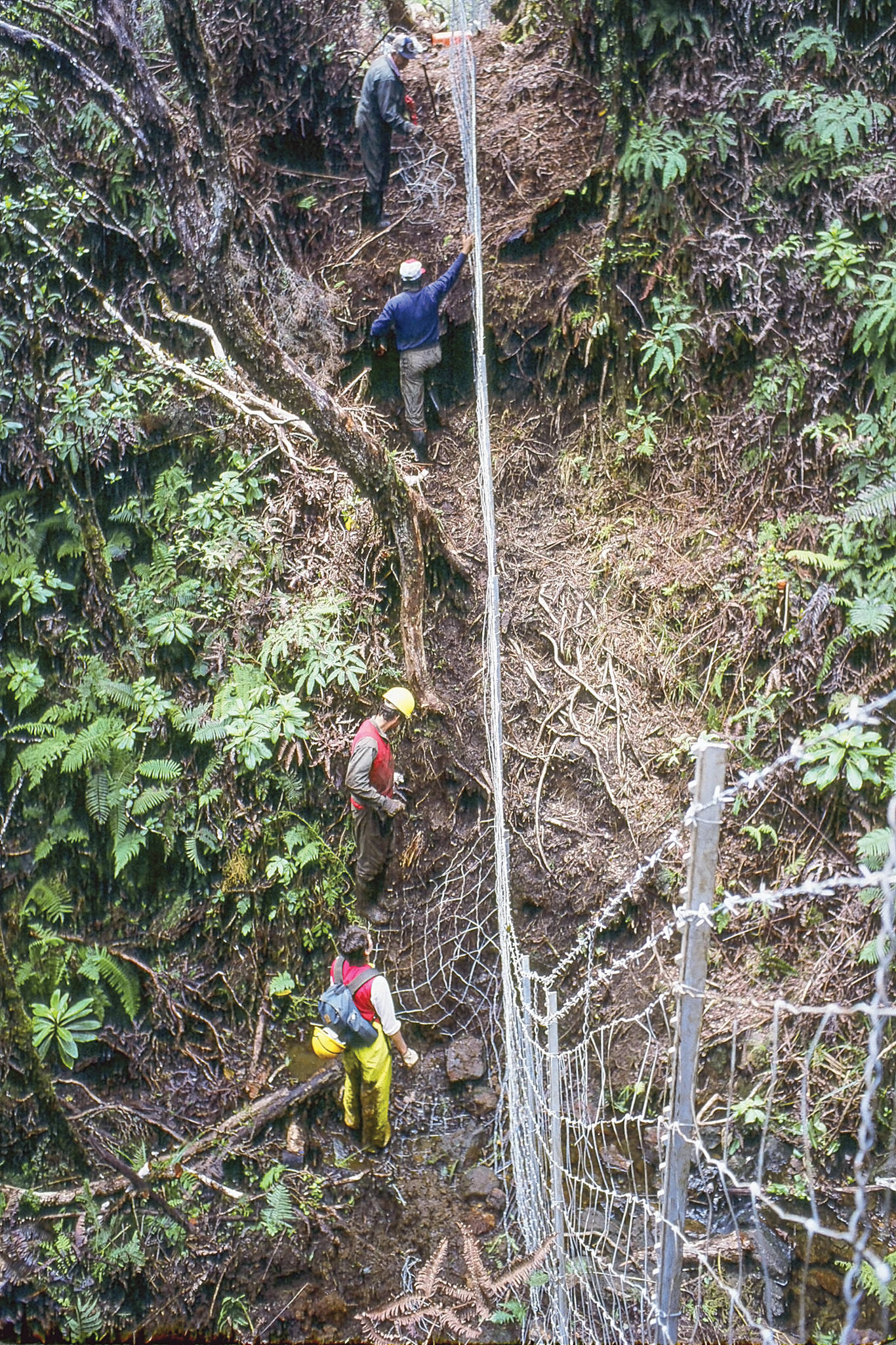
WHILE THINGS WERE looking hopeful at Hawai‘i Volcanoes National Park in the mid-1970s, the outlook for Haleakalā was bleak. Feral goats and pigs had pushed up the Ko‘olau and Kaupō gaps. Left unchecked, soon they were on track to destroy the delicate summit ecosystem.
By 1975, the University of Hawai‘i Cooperative Park Studies Unit under Dr. Cliff Smith initiated research at Haleakalā National Park. The findings provided the scientific background that supported the removal of goats and pigs.
In 1976, the first group of fencing volunteers – led by then-Sierra Club volunteer Ron Nagata and with the blessing of Haleakalā National Park Superintendent Hugo H. Huntzinger – started testing a barbed-wire electric fence. Two years later, the park hired Nagata to work as a backcountry ranger and to manage the park’s fencing program. By 1980, however, it was clear the electric fence was not working.
The real work then began: methodically replacing the barbed-wire electric fence with hog wire mesh fencing and continuing all around the mighty elongate bowl of the summit.
It was absolutely grueling work at high altitudes, on steep slopes, and in wildly erratic weather. It sometimes required flying in and out by helicopter to remote field camps, hard handwork, hauling heavy gear like rock drills and pole pounders, and a willingness to work very hard in the determined service of a specific ideal: no goats in the summit wilderness.
The fence line had to first be brushed – a term that means hand-clearing a swath wide enough on which to unroll the fence. Next came post holes every 10 feet, often drilled into rock.
The hog wire mesh was 4 feet tall, with two strands of barbed wire over it. Every foot had to be stretched and clipped by hand down the faces of valleys, along slanted slopes, in the muddy forest, and in the unrelenting sun beating down on rocky, gritty volcanic terrain.

Fence funding was tenuous. “After Hugo hired me,” Nagata said, “I asked him who was going to maintain the fence, and he said, ‘That’s what I hired you for. Just keep building it and hopefully, we’ll get funding later.’ ”
Nagata recalls taking Huntzinger and Harry to survey goat damage at the Kaupō Gap around 1980. They had never seen that kind of environmental devastation. The visit spurred the funding they needed, with priority on Kaupō Gap and the South Slope of Haleakalā.
Nagata secured more funding in 1983 and immediately hired seasonal employees to tackle Kaupō Gap – by all accounts the most difficult place to fence and the area most damaged by goats.
In 1982, Chris Alexander came to volunteer at Haleakalā. He came back the next summer as part of the seasonal fence crew, often flying with the workhorse machines of conservation: helicopters and their brilliant, and sometimes eccentric, pilots.
Tom Hauptman, in particular, was a pilot with uncanny skills for picking up and delivering 100-pound repair bundles of wire, clips and tools. He would pick up the bundles using a mirror mounted on his skids, positioning himself to clip the load onto the belly of the helicopter without getting out of the helicopter, Alexander said.
Hauptman became famous in conservation circles for inventing a way to deploy a 330-foot roll of fence from the helicopter with an A-frame contraption akin to a toiler paper roller. With one end of the fence anchored on the ground, the hog wire unspooled itself as the helicopter slowly lifted away. Before Hauptman’s invention, crews unrolled spools by hand on the rocky, jungly and rough terrain.
Alexander remembers one trip that didn’t go as planned. Hauptman dropped a repair bundle from his helicopter along a steep fence. Instead of staying put, the bundle started rolling and bouncing downlope.
“All of a sudden, we go straight up in the air and then he starts turning, drops us downhill, and he stopped the bundle with his skids,” Alexander said. “He was like a sheepdog herding sheep with a half-million-dollar piece of machinery.”
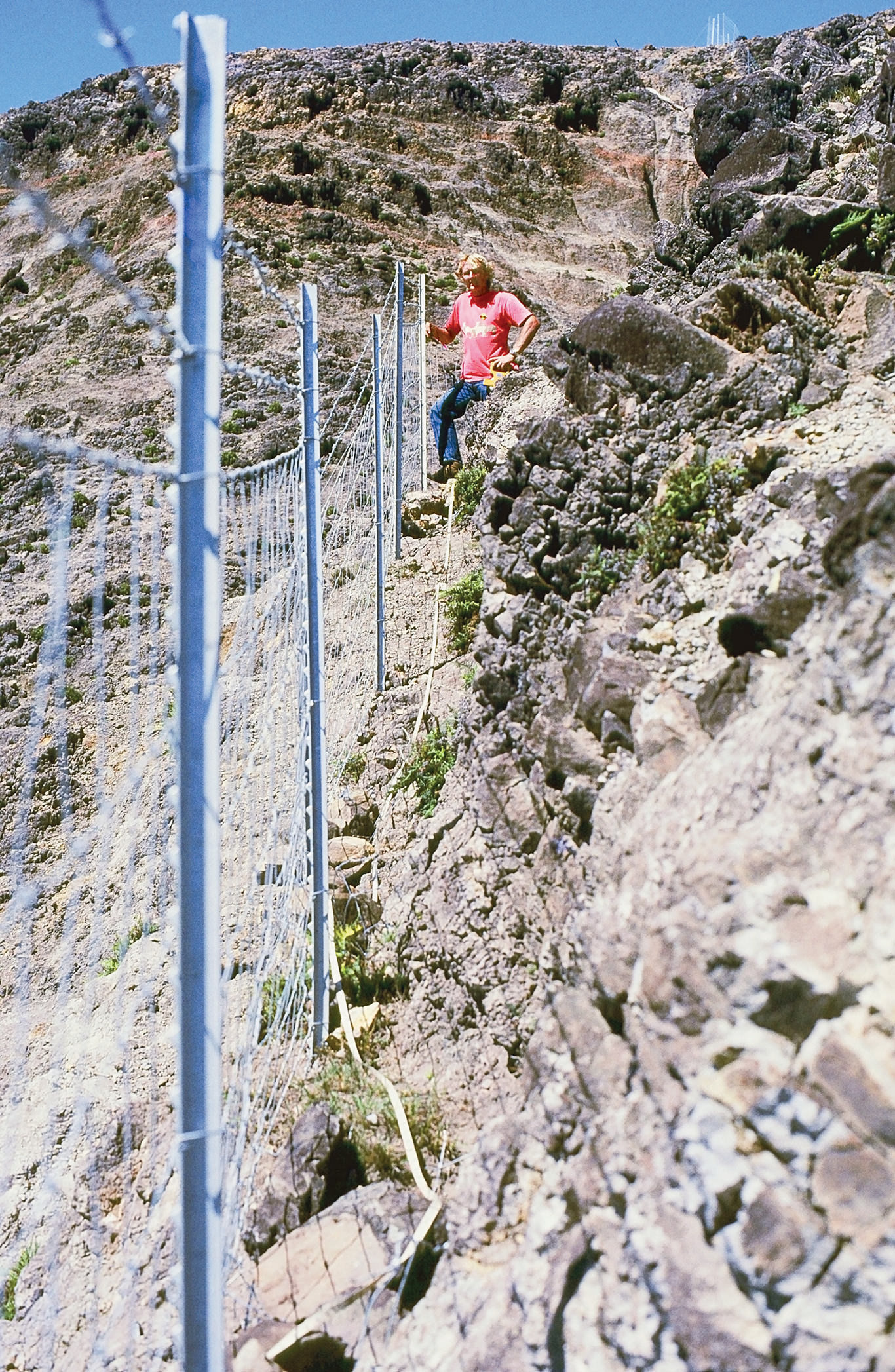
THE WORK CONTINUED under Nagata through the 1980s. In 1987, Nagata became the first chief of resources management and put Ted Rodrigues in charge of the fence. In 1988, Don Reeser (previously of Hawai‘i Volcanoes National Park) became Haleakalā National Park superintendent, bringing his fencing expertise with him and staying on through a legendary career until 2005.
Over the following years, the visionaries who dedicated themselves to the Haleakalā summit boundary fence would shake out as some of the foremost heroes, movers and achievers in Hawaiian conservation, including botanist Betsy Gagne, Terry Quisenberry Jr., Mike Ing, Cathleen Bailey, Randy Bartlett, Joel Lau, Scott Rowland, Dr. Sam ‘Ohu Gon III, biologist Dr. Art Medeiros and Dave Lassner, the current president of the University of Hawai‘i.
According to the National Park Service, “By 1991, the last of some 17,000 goats had been cleared from the park. Today, more than 85 miles of fencing protect the summit and Kīpahulu (District), and the work continues.” Silversword populations rebounded to 65,000 by the same year, though numbers have slipped to between 30,000 and 40,000 today.
Ron Nagata retired from the National Park Service in August 2009, in the middle of a major fence replacement program managed by Ted Rodrigues. The day before he retired, he ceremonially connected one last bit of fence to a cattle guard on the park road just below the summit.
The work is far from over. Since the summit was enclosed, further legs of the fence have been built, and the summit fences always need repairs. Like the CCC fence of the 1930s and ’40s, the current fence is degraded by the sun, wind and freeze-thaw cycles. Determined goats, relentless pigs and axis deer find ways to push through to greener pastures on the protected side.
The mantle of fencing responsibilities today falls on Timmy Bailey, who is also the park’s aviation manager. The grueling work of pounding posts, unspooling wire and mending holes goes on.
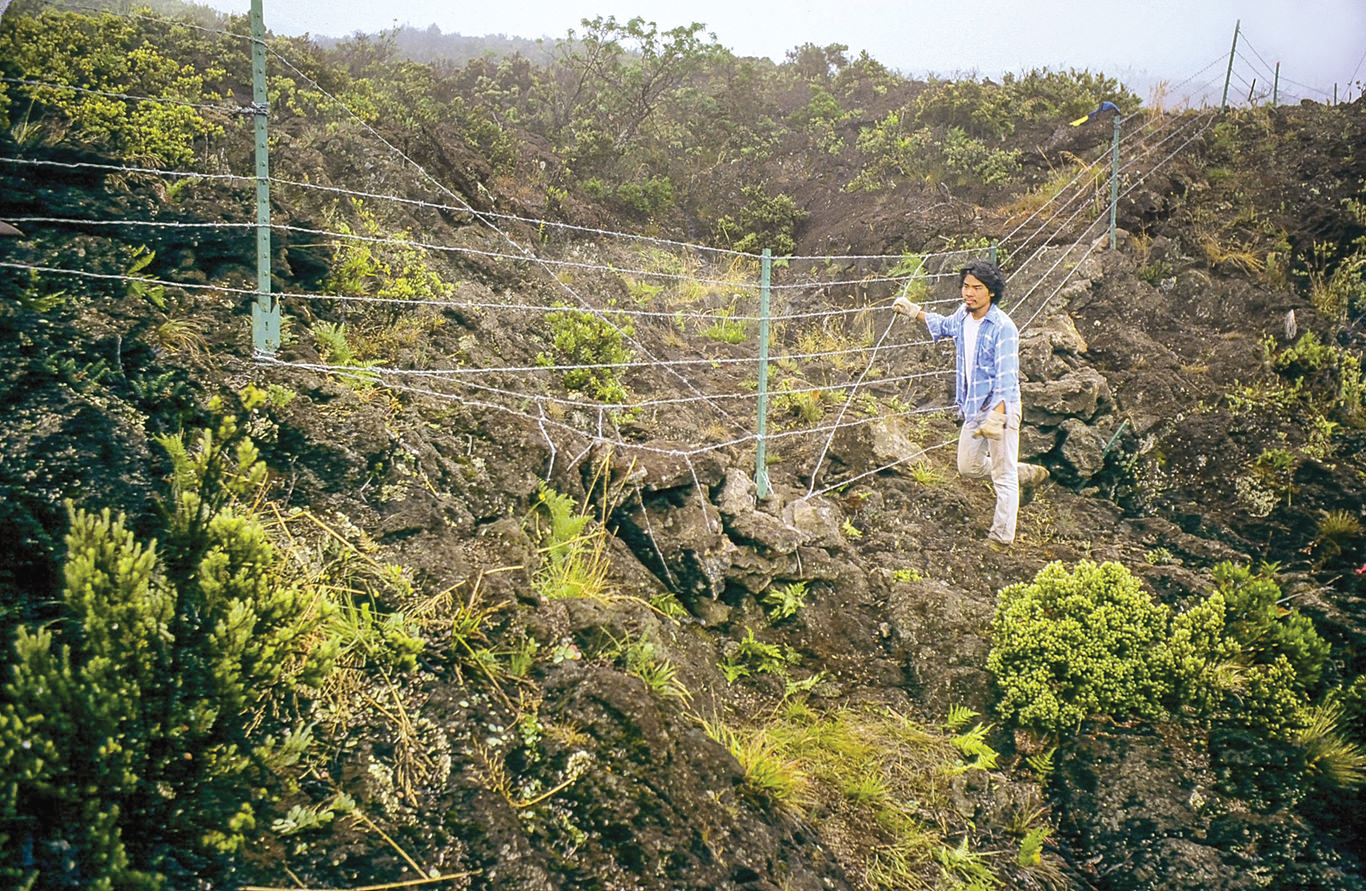
One of the many wonderful outcomes of having the fence in place is that Hawaiian petrels began to nest successfully again, their burrows no longer crushed by goats. Their love-struck seasonal mooing in the cliffs above Hōlua Cabin is a highlight of the Haleakalā camping experience.
Bryan Harry, reminiscing, said, “Once we figured out how to do the impossible, we made it possible.”
In remembering their monumental fencing efforts, Harry likes to reference what he calls “The art of muddling through.” The steps of which go as follows: One, figure out where you are. Two, define where you want to be.
“And you don’t know how to get there,” he said, “you embark, and you monitor your progress, and you modify, and keep modifying your muddling through until eventually you get there.”
Then he added, “Keep your fences mended.”
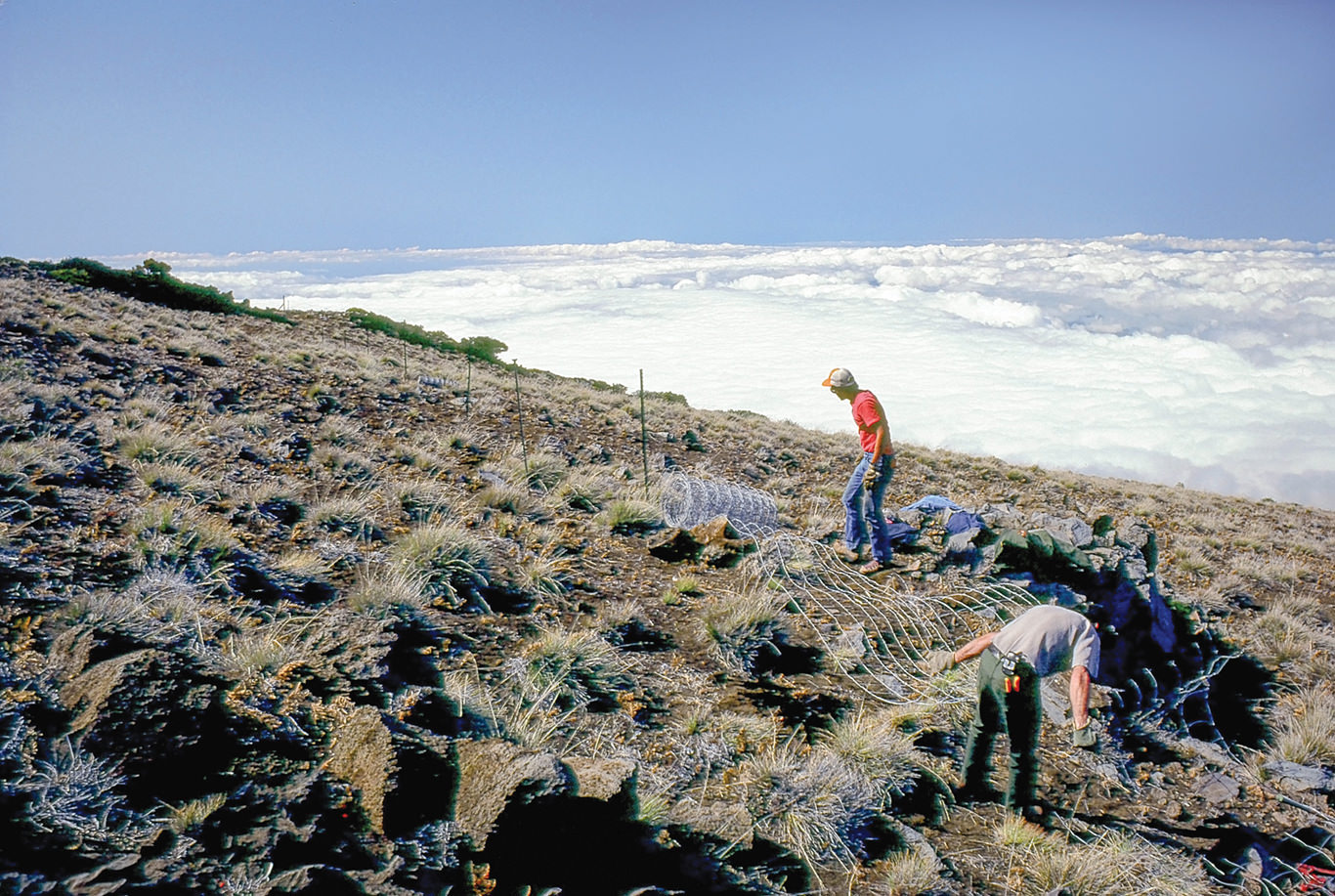
Click here to subscribe to Maui Nō Ka ‘Oi Magazine





